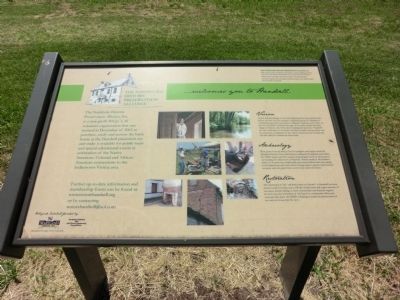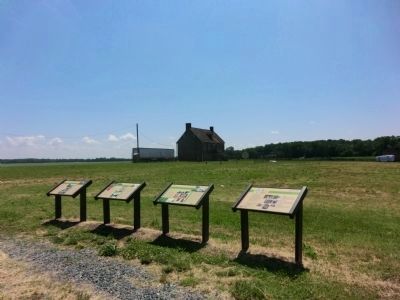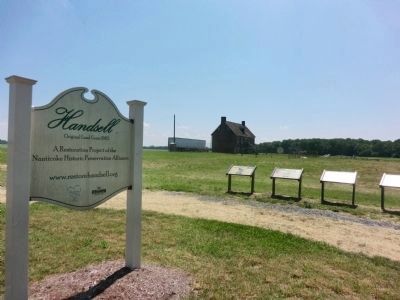YouTube video in 2010 about Handsell House...HERE
"Indiantown Road in Vienna, MD seems unassuming at first glance. Open fields of farmlands, trees, and houses at distant intervals, no one would have guessed it has one of the only remaining colonial plantation houses left in the state. This structure is known as the Handsell House, named for the term "handsell" which means "honest money." This name was given to refer to the area's function as a trading post with American Indians. The house, when it was built, changed hands several times in its early life. It became a site of much strife through the 1700s, first because of more and more Englishmen encroaching upon the natives' territory, and also because of British raids taking place there around the time of the Revolution.
"When I visited the house, I met the restoration crew in the midst of their cleaning operation and study of artifacts. They were working towards their goal of developing an accurate picture of the original house, which they hope to utilize when they restore it to its former beauty. Hopefully in a few years, after the work is finished and word gets out, the house will be top on the list of visitors to Dorchester County. (from YouTube description)
Jamboree at Handsell House a video
The link above goes to a video from 2012, where lots of things were happening at the Handsell House in Vienna, Dorchester County, MD.
2nd Annual Nanticoke River Jamboree held at Handsell, the historic site near Vienna, MD. The event featured groundbreaking on a Native-American lodge, War of 1812 reenactors, talks about Harriet Tubman and local African-American history, a program on Native-American life skills, nature walks, Colonial-era blacksmiths, and tours of Handsell. The Jamboree was sponsored by the Nanticoke Historic Preservation Alliance (NHPA).
The Nanticoke River Jamboree is an annual event held at Handsell to celebrate the natural and historic resources of the Nanticoke River watershed area and three cultures who have occupied this land. Each year the Jamboree features exhibits and demonstration by regional environmental and historic groups, a variety of living history performers and demonstrations by spinners, sheep-shearers, wood turners, open hearth cooks and more! In addition you will find music, food and activities for the whole family.
The 2019 Jamboree was held Oct. 12 of this year, (2019) before I (your blogger) even knew about it! Here was their preview, with lists and descriptions of the demonstrations:
Historic Handsell to Host Nanticoke River JamboreeOctober 12 (2019) @ 10:00 am - 5:00 pm
Visitors to Dorchester County’s largest living history event will enjoy hands-on interaction with a variety of activities on October 12 at the 9th annual Nanticoke River Jamboree at the historic Handsell site near Vienna.
Designed as an event for families, the Jamboree will feature open-hearth cooking as experienced by African American slaves, displays and hands-on demonstrations by Native Americans who once lived on the site, and crafts of early European settlers who built the house at Handsell hundreds of years ago.
In addition to displays and demonstrations by people in period dress, this year’s Jamboree will showcase model boats crafted after historic vessels of the Chesapeake as a tribute to Dorchester’s 350th Anniversary and the Smithsonian Water/Ways Exhibit. Examples include native dugout canoes, skipjack, deadrise oyster boat, crab scrape, log canoe and skiff, among others.
“The Jamboree is a way to take people back in time, to partake in a fun variety of historic skills and craft activities that African-Americans, Native Americans, and European settlers engaged in during three centuries in America,” said Midge Ingersoll, a trustee and president of the Nanticoke Historic Preservation Alliance, which owns and maintains Handsell.
Handsell honors three cultures that made up its history: Native Americans who lived in a sprawling Chicone Village at the site, European settlers who built the house at Handsell around 1770, and African Americans, who worked as enslaved and free people at Handsell. The Jamboree’s purpose is to educate visitors through living history presentations.
In the kitchen at Handsell, Jerome Bias, of the Slave Dwelling Project, will be demonstrating activities from a 19th century plantation kitchen while discussing life as an enslaved cook. Dontavius Williams will be performing “The Chronicles of Adam,” an interpretation of life as an enslaved person of the 19th Century. Noah Lewis will portray “Ned Hector,” a Revolutionary War soldier. Nearby, Roberta Perkins, a “laundress,” will be discussing 19th century life as an enslaved woman, recently freed, for the family at Handsell.
Living history interpreter Rachel O’Connell will demonstrate many favorite 18th century activities such as: trapball, croquet, Game of Graces (hoop toss), Shut the Box (dice game), lawn bowling, mirror box, Newtons Inertia toy, tablecloth pull trick, friction tug o war, bed of nails, and singing wine glasses.
Antique doll specialist Carolyn Hoiler, of Crisfield, will display and discuss early period dolls. In addition to the new performers, traditional crafts people and living history interpreters will also be exhibiting at the Jamboree as they explore life in the 18th and 19th centuries. This year there will be more craftspeople than ever and will include basket weaving, wood lathe turning, doll making, spinning, rug-hooking, wool dyeing and broom making.
Representatives from the Pocomoke Indian Nation, the Lenni-Lanape of Delaware, Hermann Jackson of the Nanticoke of Delaware and Nause-Waiwash Band of Indians as well as Handsell’s own Village Volunteers will explore many life skills of the Native people who once lived at Chicone. These demonstrations include fire-making, weaving, pottery, chipping of implements, and techniques used for the building of the longhouse. These demonstrations occur in the Chicone Village (longhouse, garden and work shelter) and are ongoing through the day.
Drew Shuptar-Rayvis, a new addition to the Jamboree family travelling from Connecticut, whose traditional name is Pekatawas MakataweU (Black Corn) is an Algonkian living historian of the 17th and 18th century of Accomac and Pocomoke descent. He has interpreted Algonkian life for a multitude of institutions and will be interpreting late 17th century Pocomoke life on behalf of the tribe for the Jamboree. Acclaimed flutist Ron Warren will be entertaining visitors with his mystical native-inspired music throughout the day.
Handsell is located on the site of the pre-historic Native Village at Chicone, later set aside as an Indian Reservation (1721-1769). Today it is a State and National Register Listed Historic site, held with a Maryland Historic Trust Preservation Easement on a Maryland Scenic By-Way and listed on the Michener Chesapeake By-Way and John Smith Historic Water Trail.
Partner organizations for the 2019 Nanticoke River Jamboree are the Harriet Tubman UGRR Visitors Center and State Park, National Underground Railroad Network to Freedom, and the National Park Service. Business sponsors include NRG Energy, Healing Hands Animal Hospital, Dorchester Center for the Arts and Chesapeake Country 106.3 FM.
And of course Handsell House has a FaceBook site as well.






















